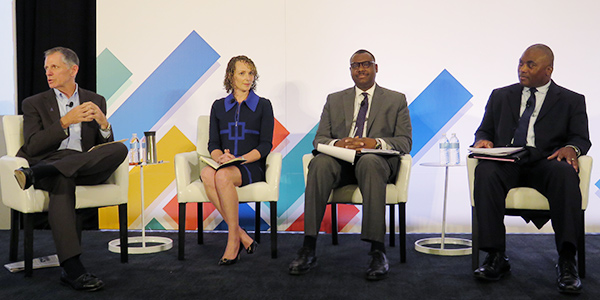By Rich Heidorn Jr.
PHILADELPHIA — Has weather become so extreme that utilities should end the universal service model and stop serving at-risk locations?
It’s something that should be considered, Margaret Peloso, a partner in Vinson & Elkins’ Environmental & Natural Resources practice, told the Edison Electric Institute 2019 meeting last week.
Peloso cited the National Oceanic and Atmospheric Administration’s National Climatic Data Center, which found that between 1980 and 2018, the U.S. averaged 6.2 extreme weather events per year that resulted in $1 billion or more in damages (inflation adjusted to 2019). In 2014-18, the count of $1 billion events doubled to 12.6 per year, and in 2018 alone, there were 14 such events, including hurricanes, severe winter storms, floods and wildfires.
“We are seeing an increase in these really big, really high-dollar-value events,” Peloso said. “When you start to look at our structures for disaster relief and how we socialize disaster costs, we’re going to run out of money. And it raises the question: Who should pay for it?”
Peloso said the problem is a combination of climate change producing more severe events and more people living in high-hazard areas because of poor land use policies stemming from “misaligned” incentives. Local governments, which control zoning, benefit from an increased tax base and thus tend to be permissive and reluctant to risk litigation by denying landowners the right to build on their properties. And when there are losses from flooding or wildfires, much of the cost is externalized to the state and federal government.
In addition, research has shown that people underestimate risk and underinvest in insurance and risk mitigation, Peloso said.
“If you’re really looking at managing the risks for your company, as the CEO, I think it’s time to reconsider the universal service model and ask: Are there some areas that are just too exposed to natural hazards and risk to really be served?
“There’s actually a small utility in California … that couldn’t get general liability coverage this year because of wildfires,” Peloso said. The utility identified about 600 customers in high-risk areas. “They gave them all generators. And they said, ‘We’re going to shut your power off’” at times. (See related story, Fire Season Starts in Calif. with Power Shutoffs.)
“Let’s try to move away from this paradigm … of putting things exactly back where they [were],” she said. “Maybe that’s not where we really want people to live.”
Combining Efforts
The consequences of the current policies are stark. After a wildfire is extinguished, “we’re left with a landscape that’s going to take, in many cases, several decades to recover,” said Barnie Gyant, deputy regional forester for the U.S. Forest Service. “In some of the cases where we’ve had really large fires … it will be 100 years before we have a forest again.”
Gyant said government agencies need to work more closely with utilities and the owners of forest lands to coordinate preventive measures. In California, he noted, his department manages more than 60% of forested landscape and 20% of the landmass, giving it overlapping responsibilities with state and federal fish and wildlife agencies and utilities.
He cited the 2017 memorandum of understanding the Forest Service signed to improve coordination with Sierra Pacific Industries, which manages nearly 1.9 million acres of timberland in California and Washington. Other industrial landowners have signed the MOU since.
“Most everyone has five- or 10-year plans, but those plans are done in a vacuum. They’re not connected,” Gyant said. “When you look at the amount of money and resources those different entities have, I think we can make a difference with the fires in California. … We’re not saying we’re going to stop fires. But I do think we can be strategic in where we place our treatments to reduce the size of those fires, help protect communities and help protect infrastructure.”
Peloso agreed, saying policymakers should resist “throwing dollars at things like management per mile as opposed to trying to be smart about where the highest risks are.” Spending should be based on “where you get the most meaningful risk reduction instead of doing things [that] we think will generally reduce threats,” she said.
Resistance to Vegetation Maintenance
Former Florida Public Service Commissioner Ronald Brisé, now a government affairs consultant for Gunster, said utilities and regulators often meet resistance from local government over vegetation management efforts.
“Some cities will tell you … I’m going to sue you if you cut my trees,” he said.
Some areas that suffered outages following Hurricanes Irma and Wilms “are the same cities [where] their citizens are reacting because of vegetation management.”
IDACORP CEO Darrel Anderson, who moderated the discussion, complained of having to deal with separate sets of rules for his company’s operations in Idaho and Oregon.
In Idaho, the company can use a soil sterilant to prevent vegetation growth around its poles, a technique he said is proven to reduce the impacts of fire on electric lines. “In Oregon, we can’t do that unless we do a separate environmental study on each pole,” he said.



